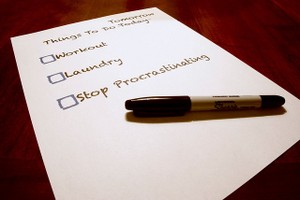You know that certain behaviors keep you feeling good and that certain activities and habits lead you to places you'd rather avoid.
But you're only human(!) and when life gets busy or stressful, when symptoms flare up or even when you just start feeling really great for a while it's all too easy to forget those habits and behaviors that maintain wellness.
You already know what works - the trick is making sure you incorporate these positive habits into your daily life - that's what's hard, and that's where wellness sheets can make a big difference.
These activity plans were developed by other people with psychiatric or emotional symptoms and they are proven to help you maintain better mental health.
They don't cost you anything but a few minutes of your time and they put you in control of the maintenance of your own well-being.
Writing Out Wellness Sheets
Wellness sheets remind you, on a daily basis, of what you must do every day and what you might want/need to do some days, to maintain wellness and to prevent the onset of unwanted emotional or psychiatric symptoms.
There are 4 steps to developing your wellness sheets:
- Brainstorm activities that you know or think make you feel good
- Write out descriptive words that describe how you act and feel when you are feeling good
- Make a list of a few simple activities that must be done on a daily basis to maintain good mental health
- Make a list of activities that might need doing on a daily basis to maintain good mental health.
Brainstorm Activities That Help Maintain Wellness and Prevent Worsening Emotional or Psychiatric Symptoms
To get the ball rolling, take 10 or 15 minutes to fill a paper with activities that you know, or think, help you feel good. Don't be too selective at this stage as you're just providing yourself with inspiration for the steps to come. Some examples might be:
- Walking the dog
- Making sure to eat breakfast
- Taking some time to call a friend each day
- Limiting the time you spend watching TV
- Getting your hair done
- Tidying up your home environment
- Getting your homework finished up early
Write Out Words That Describe How You Act and Feel When You're Feeling Good
As part of a daily practice of incorporating wellness activities into your daily lifestyle you need to get into a habit of monitoring your emotional states so you know when you need to pay extra attention to making some time for yourself.
You can help yourself in this practice by writing out a list of words that describe how you act/feel when you're at you're best and by comparing your mood and behaviors daily against your optimal self.
Some examples of words that you might use to describe yourself when you're at your best are:
- Cheerful
- Energetic
- Motivated
- Talkative
- Interested in the lives of people around me
- Relaxed
- Mindful
Make it individualized and true - there aren't any right or wrong answers here, and then compare how you're feeling each day against how you feel when you're at your best. When there's great divergence, you know you need to take some extra time to focus on wellness activities.
Make a List of Things You Must Do Each Day to Maintain Wellness
The experts say that when you find yourself feeling worse you can often trace the start of a downward spiral back to not taking adequate care of your emotional or physical health - to forgetting to do something that must be done to maintain good health on a daily basis.
To help avoid this, make a very short list of essential activities - things you must do each day to keep yourself feeling good (don't make your list too long or complicated or you'll never be able to complete all list items each day...this is just the daily essentials here.)
For example, every day I must:
- Talk to a friend or a family member each day on the phone or in person
- Get out of bed before 9 am
- Eat 3 meals
- Take a shower soon after waking
- Leave the house for some outside time for at least 30 minutes per day
- Take medication
- Do at least 20 minutes of meditation or relaxation exercises
- Spend at least 20 minutes doing something fun
Reminders - Make a List of Things You Might Need to Do Each Day to Maintain Wellness
Some wellness promoting activities are done only occasionally, like visiting your doctor or therapist, and others, like doing laundry, need doing regularly, but not daily.
Getting behind on chores and obligations leads to increased stress and aggravation and forgetting important occasional activities can reduce quality of life.
For your daily reminder sheet make a list of chores, activities and obligations that you need to keep on top of to maintain wellness.
For Example:
Today, Do I Need To?
- Make or attend a doctor or dentist’s appointment?
- Do laundry or clean my living space?
- Complete a work or school task?
- Go to a support group meeting?
- Spend time with a loved one?
- Buy food for the house?
- Go to an exercise or yoga class?
Daily Attention Makes a Big Difference
Remember to consult your daily wellness activities and reminders lists every day and remember also to edit your lists whenever appropriate, adding activities that help and erasing activities that no longer provide you with much of a boost.
By thinking hard about what you need to do each day to stay happy and healthy and by structuring these activities into a daily routine you can do a lot, by yourself, to maintain wellness and to prevent worsening emotional or psychiatric symptoms.1
- References
Page last updated Sep 17, 2012


